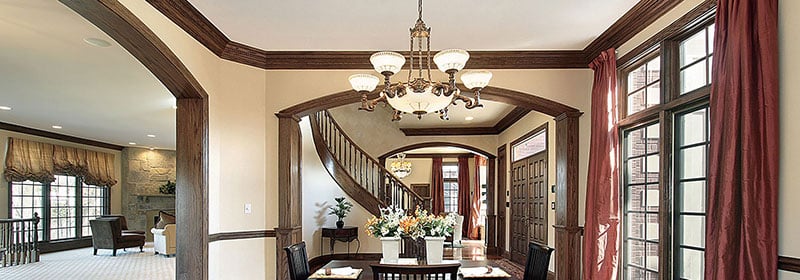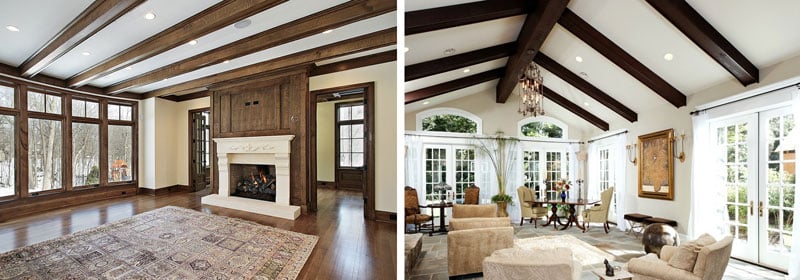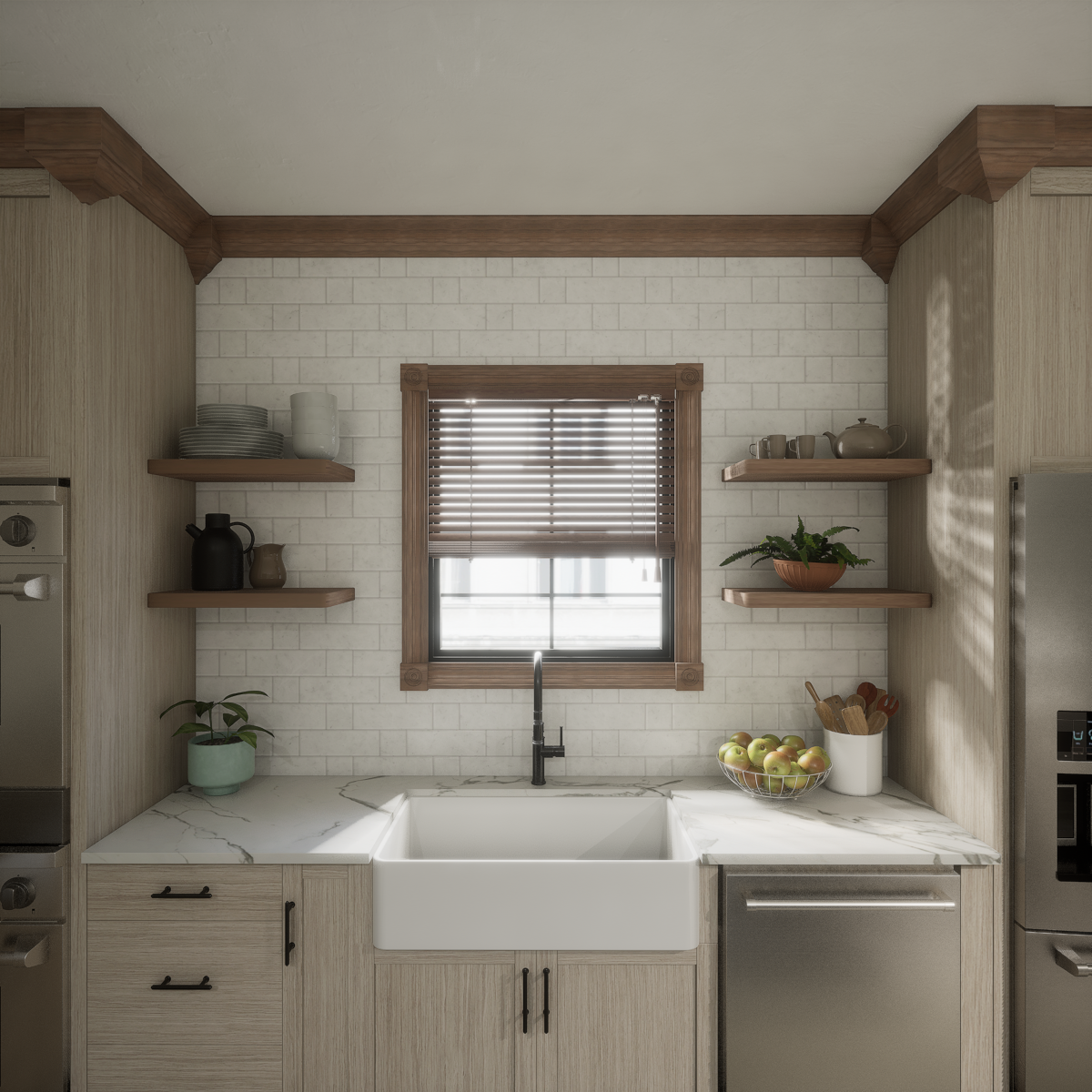Wood millwork, including moulding, beams, shutters, slat walls, and brackets and corbels, adds distinctive character and charm to both the interior and exterior of your home. Proper maintenance is crucial to preserve its natural charm and ensure it lasts for years. This guide will provide you with practical tips on how to keep your wood millwork looking its best, whether interior or exterior.
1. Regular Cleaning
- Dusting: Regularly dust wood millwork using a soft, dry cloth or a duster. This prevents dirt buildup that can dull the finish. For intricate designs, use a vacuum with a soft brush attachment.
- Surface Cleaning: Use a damp cloth with a mild soap solution for deeper cleaning. Gently wipe the wood following the grain, avoiding excessive moisture.
- Avoid Harsh Chemicals and Abrasive Cleaners: Test any new cleaning solution on a small, inconspicuous area first.
Special Considerations:
- Outdoor: Outdoor wood millwork may require more frequent cleaning due to exposure to elements. Use a garden hose with a gentle spray to rinse off dirt before applying a mild soap solution. Avoid using high-pressure washers as they can damage the wood.
2. Moisture Control
- Moisture can cause wood to swell and warp, leading to structural distortion and surface damage. Over time, persistent dampness can also promote mold and rot, compromising the wood’s integrity and durability.
Preventing Moisture Damage to Wood (General Tips):
- Seal and Protect: Always apply a protective finish, such as a sealant, varnish, or paint, to create a barrier against moisture. This helps prevent water from penetrating the wood and causing swelling, warping, or rot.
- Ensure Proper Ventilation: Good airflow is essential to prevent trapped moisture, especially in humid environments. Ensure that areas around the wood are well-ventilated to allow excess moisture to evaporate.
- Address Leaks and Spills Quickly: Any water exposure, whether from leaks or spills, should be cleaned up immediately to prevent the wood from absorbing moisture.
- Regular Inspections: Frequently check for signs of moisture buildup, such as discoloration, swelling, or soft spots. Addressing issues early can prevent long-term damage.
Repairing Moisture Damage:
- Drying and Sanding: For swollen or warped wood, dry the area thoroughly and lightly sand to restore a smooth finish. Refinish as needed.
Special Considerations:
- Indoor: Ensure good ventilation in areas prone to high moisture, such as bathrooms or kitchens, to prevent mold growth. Maintain stable indoor humidity levels to prevent wood expansion or contraction. Use humidifiers or dehumidifiers as needed.
- Outdoor: Protect exterior wood from water damage by ensuring proper drainage and sealing joints. Use waterproofing treatments or sealants appropriate for exterior use.

3. Protection from Sunlight and Heat
- Heat and sunlight can cause wood to dry out and become brittle, leading to cracking and splitting. Prolonged UV exposure can also fade the wood’s color and degrade its finish, reducing its aesthetic appeal and protective qualities.
Protective Coatings:
- Reapply Finish: Regularly reapply a protective finish or clear coat to maintain wood appearance and shield it from UV damage.
Special Considerations:
- Indoor: Protect interior wood from UV damage by using window coverings or UV-filtering films. Keep wood away from direct heat sources like radiators or stoves to prevent drying and cracking.
- Outdoor: For exterior wood, use UV-resistant finishes and sealants designed for outdoor use. Regularly check and reapply coatings to ensure lasting protection.
4. General Maintenance
Inspecting for Damage:
- Regular Checks: Periodically inspect wood millwork for damage such as scratches, dents, or loose parts. Address issues promptly to prevent further deterioration.
Minor Repairs:
- Filling Scratches and Dents: Use wood filler or wax sticks to repair minor damage. Apply, smooth, let dry, then sand and refinish.
- Tightening Loose Parts: Tighten any loose components like brackets or corbels, ensuring secure attachment.
Special Considerations:
- Outdoor: Inspect for weather-related damage and pest issues. Promptly address any problems to prevent extensive damage.

5. Refinishing and Restoration
The frequency of refinishing wood depends on its location and exposure to elements. Generally, interior wood surfaces should be refinished every 5 to 7 years, while exterior wood may need refinishing every 2 to 3 years due to harsher environmental conditions.
Preparation:
- Cleaning and Sanding: Clean and sand wood to remove old finishes, dirt, or imperfections before refinishing. Use fine-grit sandpaper and sand with the grain.
Repairing Damage: Address damage like cracks or splits with wood filler or epoxy before refinishing.
Applying New Finish:
- Staining and Painting: Apply stain or paint to achieve the desired color and finish. Use brushes or cloths for even application. Allow adequate drying time between coats.
- Topcoating: Finish with a clear protective topcoat, such as polyurethane or lacquer, to enhance durability.
Special Considerations:
- Indoor: Indoor wood refinishing typically requires less frequent attention but ensure ventilation during the process and use low-VOC products when possible.
- Outdoor: Exterior refinishing requires durable, weather-resistant products. Reapply finishes as needed based on weather exposure and wear.
6. Preventing Insect Damage
General Prevention:
- Regular Inspections: Frequently check wood millwork for signs of insect activity, such as small holes, frass (insect droppings), or unusual dust. Early detection is key to managing infestations before they cause significant damage.
- Eliminate Attractants: Reduce conditions that attract pests by maintaining low moisture levels and ensuring proper ventilation.
Special Considerations:
- Interior:
- Control Humidity: Keep indoor humidity levels stable to prevent wood from becoming a conducive environment for pests like termites and beetles. Use dehumidifiers in high-humidity areas.
- Regular Cleaning: Ensure that dust and debris are regularly cleaned, as they can attract pests or provide food sources for them. Pay special attention to areas like baseboards and around furniture. In areas where food is prepared or consumed, ensure proper storage and disposal to prevent attracting insects.
- Exterior:
- Protective Treatments: Apply insect repellents or treatments designed for exterior wood to deter pests such as termites and carpenter ants. Regularly inspect and reapply treatments as needed.
- Proper Drainage: Ensure that rainwater drains away from wood surfaces and that wood is not in direct contact with soil or standing water, which can attract pests. Use protective barriers, such as metal flashing, to prevent pests from accessing wood structures.
- Avoid Soil and Foiliage: When possible, keep your wood millwork away from soil and do not allow it to come into contact with bushes and other vegetation around your home. These can provide insects with a path to your wood. For wood in contact with soil, use physical barriers or treatments to prevent pests from accessing the wood.
By following these maintenance tips, you can keep your wood millwork looking its best and ensure its longevity, whether it’s installed indoors or outdoors.


